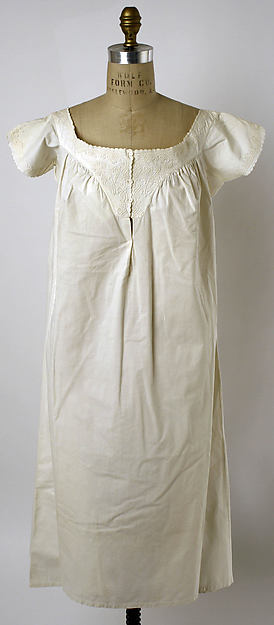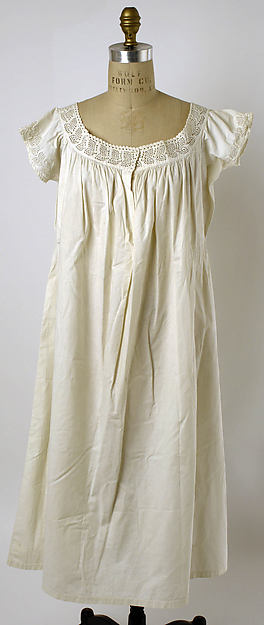 |
| Chemise from Der Bazar, 1865 |
"...a good chemise may be made for ten pence or one shilling; and this being worn next the skin, is the most important to have constantly changed."
--The Christian Miscellany, 1863
Chemises of the 1860s typically have short sleeves and fit loosely over the body; the fullness is gathered into a yoke or band which fits smoothly from shoulder to shoulder, giving the garment a wide but shallow "boat" neckline. They often fasten with one or more buttons at the center front, and some may be snugged with drawstrings. The chemise length varies by wearer, typically ending around the knee (period cutting instruction most often call for the body piece to be 45" long, which put it at the mid-to-upper calf of a women 5'2"-5'5"). The hemline is generous to avoid impeding movement, and it may be widened by the use of gussets set into the sides of the chemise. The chemise is made of white cotton or linen, for easy washing.
 |
| Chemise from Peterson's Magazine, 1860, page 475-6 |
 |
| Diagram of Chemise, from Peterson's Magazine, 1860 |
Chemises may be made at home, and the large number of diagrams and instructions in sewing books, textbooks, and popular magazines of the 1850s and 60s, suggest that home manufacture was the most common way to produce chemises. Trousseau descriptions also recommend starting with the underclothing, as it is most likely to be made at home. That being said, some undergarments were available for sale in the 1860s.
 |
| Advertisement from the Illustrated London News, 1863 "A stock always on hand of Chemises, Nightdresses..." |
 |
| Reduced-bulk technique for chemises, from Godey's, 1859 |
Many persons dislike to have any fulness (sic) under their corsets around the waist. The pattern given is very good in avoiding that difficulty. Cut the chemise in the ordinary way. The neck can be finished with either band or yoke. Below the waist on the back, cut the chemise nearly across, leaving about four or fire inches on each side. Gather the fulness from the lower part into a narrow band. Then take all the fulness from the top part except just sufficient to fasten it into the band around the neck, making a small seam up the middle of the back. For those who like a full garment, but not much around the waist, this is a very nice pattern. Join the top to the band, inclosing the fulness below.As they are meant for easy washing, chemise decoration runs towards white-work embroidery, particularly along the bands or yoke, or on the sleeve. While embroidery is the most common decoration in extent garments or in magazine suggestions, sturdy tatted lace or self-fabric frills are also possible, likewise valciennes lace which "best sustains the severe ordeal of the laundry". Cassell's Household Guide (1869) advises that chemises be left plain in general, the exceptions being for evening wear or as part of a bride's trousseau (which ideally should contain twelve months worth of undergarments).
--Godey's Lady's Book, 1859
 |
| A few of the chemise band embroidery patterns published in Godey's in 1859. |
 |
| Cotton chemise with extensive white embroidery and braidwork on the yoke, c. 1856. From The Met. |
 |
| Linen chemise with broderie anglaise on the band and sleeves, c.1860-65. From The Met. |
How many chemises does a woman own? Sewing instructions assume twelve chemises being made at once, as they can be cut out more economically that way. A US bankruptcy case from 1842, lists six changes of underclothing among the petitioner's wife's clothing. Laundry, travelling, and wedding advice also offer some clues.
While I cannot find the reference at present, I once read some advice that ladies keep at least two weeks' work of undergarments: one set for wearing while the other was being washed; three sets would allow the laundry to be sent out less often. Having lots of linen is also crucial to this 1841 plan for improving household efficiency by only washing clothes once every five or six weeks.
A selection of practice conversations in French and English (1851) mention two dozen chemises being packed for a trip. British travelers to India in 1854 are advised to pack six dozen chemises for day wear (but only four dozen pairs of drawers and of cotton stockings). For immigrants to Australia and New Zealand in the early 1850s, one advice book recommends 12-18 chemises (in addition to ones already owned), Other guidebooks suggest between 6 and 24 chemises per female passenger, with the latter figure explicitly assuming a four-month ship voyage and limited access to wash water. Another thing to consider is wardrobe proportions: one guidebook calls for immigrant women to pack 12 chemises (the same as the number of cotton stockings), while only suggesting 3 dresses and 2 bonnets.
Trousseaux are intended to lay in a supply of garments for the new bride's first year or so of housekeeping, giving her more time to arrange the house and get used to her new duties. Harper's Bazaar (1868) recommends about two dozen cotton and linen chemises, some plain and some decorated, the exact number to depend on how many are already owned. Princess Anne of Prussia reportedly had "twenty-four dozen day and night chemises" in her 1853 trousseau; biographies of Catherine the Great published in the 1850s underline her poverty by describing a trousseau of only twelve chemises. For non-royals, the 1856 book Bridal Ettiquette mentions wealthy brides with twelve dozen chemises in their trousseaus, but notes that "those who cannot afford such luxuries, must substitute fewer articles of a more modest but durable kind." Such are likely the target audience for an 1866 magazine advertisement featuring a £20 trousseau; it includes eight chemises.
For close-ups of an original c. 1865 chemise, see The Fashionable Past.
No comments:
Post a Comment